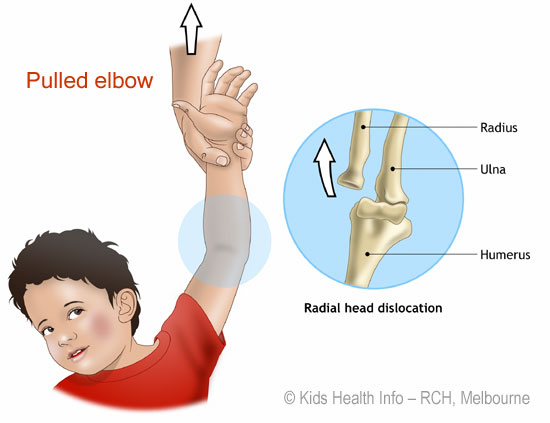A pulled elbow is a common injury among children under the age of five. It is also sometimes called nursemaid’s elbow. A pulled elbow is a result of the lower arm (radius bone) becoming partially dislocated (slipping out) of its normal position at the elbow joint.
A pulled elbow is caused by a sudden pull on a child's lower arm or wrist, for example when a child is lifted up by one arm. It can also happen when a child falls. A pulled elbow will be put back into place by a nurse practitioner or doctor. It will not cause any long-term damage to your child.
Signs and symptoms of a pulled elbow
A strong, stretchy band called a ligament normally holds the radius bone in place, but after a fall or a sudden pull, the ligament can be overstretched and the bone partially slips out from underneath the ligament.
In most cases, children with a pulled elbow will cry immediately after the sudden pull, and not use the injured arm at all. Their arm may simply hang by their side.

When to see a doctor
If you think your child has a pulled elbow, you should seek immediate medical treatment from a GP or at a hospital emergency department. The longer the elbow has been out of place, the more painful and difficult it is to put back into place, and the longer it takes to fully recover.
Treatment for pulled elbow
The partial dislocation will be reduced (manipulated back into place) by a nurse or doctor. This procedure is painful and distressing, but it only lasts a short moment and is over when the radial bone pops back into place. An X-ray is not necessary to diagnose a pulled elbow.
Your child will be observed for a short while to check that they are using their arm without any problems or pain. They may be able to use their arm normally almost immediately after the elbow is reduced, or it might take a bit longer.
If a pulled elbow is not able to be put back into place, or your child is still not using the injured arm, an X-ray may be ordered to check for other possible injuries such as a fracture. You will be advised if this is necessary.
Care at home
Once a pulled elbow has been treated, your child should be able to return to normal activities. However, if the elbow was partially dislocated for quite a while, then your child may need some pain medicine for a day or two. Follow the advice of the nurse or doctor, or see our fact sheet Pain relief for children.
If your child is not moving their arm fully by the next day, take them back to the doctor so that their arm can be evaluated again.
A pulled elbow will not cause any long-term damage to your child if treated promptly and appropriately.
Preventing pulled elbows
Some children are more likely than others to get a pulled elbow. It can happen more than once, and it may occur several times in children who have particularly loose joints.
To prevent a pulled elbow, make sure you don't pick your child up by the lower arms or wrists – lift them up using their armpits instead. Teach others who care for your child, such as grandparents and child care workers, the correct way to pick up your child.
It is unusual for children over five years old to get a pulled elbow, as their joints are a lot stronger.
Key points to remember
- A pulled elbow is caused by a sudden yank or pull on a child's lower arm or wrist, or by a fall.
- Seek immediate medical assistance, because the longer the elbow has been out of place, the more painful and difficult it is to put back into place.
- A pulled elbow will not cause any long-term damage to your child.
- Don't pick your child up by the lower arms or wrists and teach others the correct way to pick up your child.
For more information
Common questions our doctors are asked
If my child has had a pulled elbow once, is he more likely to have it again because his ligament has stretched?
Having a pulled elbow doesn’t cause any long-term damage and won’t stretch the ligament. However, some children are more susceptible to getting a pulled elbow more than once because they have loose joints and their radius bone is more likely to slip out.
My child has had a pulled elbow before, and I know how toput the arm back into place. Is it OK to do this if we are not near a doctor?
Never attempt to relocate a pulled elbow by yourself. It should always be managed by a medical professional.
My child loves it when I swing her by the hands when we are playing. Is this dangerous?
Even though it’s fun for the child, swinging them by their arms, hands or wrists puts them at risk of a pulled elbow.
Developed by The Royal Children's Hospital Emergency department. We acknowledge the input of RCH consumers and carers.
Reviewed March 2018.
This information is awaiting routine review. Please always seek the most recent advice from a registered and practising clinician.
Kids Health Info is supported by The Royal Children’s Hospital Foundation. To donate, visit www.rchfoundation.org.au.